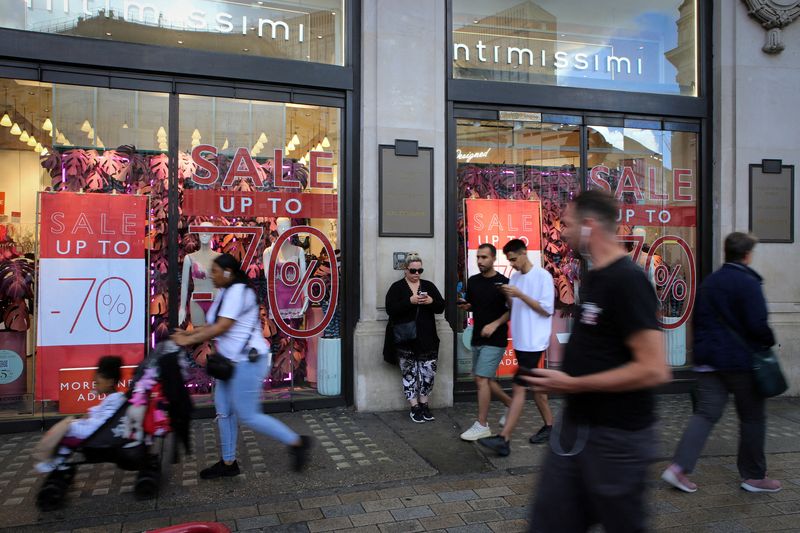Analysis – Dwindling excess savings could scupper markets’ soft-landing hopes
2023.07.31 05:15
2/2

© Reuters. FILE PHOTO: Shoppers walk past sale signs on Oxford Street, as Britain struggles with the highest inflation rate among the world’s big rich economies, London, Britain, 17 July 2023. REUTERS/Rachel Adams/File Photo
2/2
By Naomi Rovnick and Dhara Ranasinghe
LONDON (Reuters) – Markets have high hopes for a soft landing for the economy, with bonds and equities rallying. Yet a sharp drawdown in the excess savings created by COVID-19 could be a curve ball that slams into bullish sentiment.
The cash piles households built up during the lockdowns and government stimulus of 2020-2021 have long been touted by analysts and central bankers as a reason economies could avoid a deep recession.
But sky-high inflation and rapidly rising interest rates in response are shrinking this savings cushion fast.
U.S. excess savings have fallen to around $500 billion from around $2.1 trillion in August 2021, the San Francisco Federal Reserve estimates.
In Europe, Deutsche Bank reckons excess savings in Sweden, struggling to contain a property slump, have dwindled. British households withdrew money from outright savings at a record pace in May, while the government’s Office for Budget Responsibility forecasts a savings ratio of zero by year-end from almost 25% in 2020.
The end of savings won’t cause a recession with jobs markets tight. Still, a spending downturn may hasten a typical economic pain spiral of falling business investment then high unemployment.
Government bonds will shine in a recession, investors said, while dwindling savings make consumer stocks and high-yield credit assets to avoid.
“Domestic consumption is a huge part of the economies,” in Britain, the United States and the euro zone, said Janus Henderson multi-asset portfolio manager Oliver Blackbourn.
“As soon as that starts to fall apart these economies can become very, very fragile very quickly.”
RUNNING OUT
Definitions for excess savings differ, but economists generally agree that this means savings that went beyond trend levels during the pandemic.
Cardano chief economist Shweta Singh said U.S. pandemic excess savings are likely to be depleted by year-end. This comes just as the end of U.S. pandemic-era student loan repayment relief creates more pain for consumers.
In Europe, excess savings have not been spent to the same degree. Euro zone consumers stashed away an extra 1 trillion euros ($1.10 trillion) during the pandemic but a strong savings culture would likely prevent them spending this on clothes or holidays, economists said.
“Europe is a little bit further behind, but I suspect the same dynamic is playing out there and that has been about as good as it’s going to get for discretional spending,” said Zurich Insurance Group chief market strategist Guy Miller.
CAUTION
Business activity data suggests the recently-resilient services sector is weakening. European airline Ryanair warns of low demand for winter holidays and JPMorgan boss Jamie Dimon notes U.S. “consumers are slowly using up their cash buffers.”
Ben & Jerry’s ice cream maker Unilever (NYSE:), in February flagged $1.5-$2 trillion in excess household savings in China that it believed could help boost sales. It now sees a “very cautious” Chinese consumer.
Eren Osman, managing director of wealth management at Arbuthnot Latham, was cautious both on shares in the consumer discretionary sector – businesses such as car makers – and businesses selling consumer staples like cleaning products and food.
“If we do see a continuation of consumer savings wearing down with that pinch on disposable incomes,” he said, “that’s going to have an impact” on consumer businesses’ profit margins.
Janus Henderson’s Blackbourn said he was cautious on smaller stock indices more exposed to domestic consumers such as the U.S. Russell-2000 and London’s FTSE-250.
The Russell index tends to underperform the larger during downturns, according to Goldman Sachs (NYSE:).
“The concern is the same,” with the , said Blackbourn, noting this index was dominated by UK banks, consumer discretionary and industrial stocks.
Zurich’s Miller noted that U.S. and European high-yield credit indices have a 35% and 31% direct exposure to consumer cyclical and consumer non-cyclical names respectively.
BUY GOVVIES
Expecting the savings drain to hasten recessions, investors favour safe-haven government bonds.
Legal & General fixed-income manager Simon Bell said dwindling consumer savings influenced his preference for government bonds of countries like Britain and Australia, where shorter mortgage terms made households rate sensitive.
Higher housing costs plus weaker consumer spending could persuade central banks to “believe they’ve done enough” sooner rather than later, he said.
Britain’s savings are expected to run down just as fixed-rate mortgage costs jump, as households refinance loans taken out in low interest rate years with more expensive debt.
The Bank of England forecasts mortgage repayment increases of at least 500 pounds ($641.25) for 1 million households by 2026.
Investors trying to time recession are mostly focused on jobs markets, which remained hot in developed economies, said Aviva (LON:) Investors multi-asset portfolio manager Guilluame Paillat.
Still, weaker consumer spending may cool inflation. “So we do like duration,” Paillat said, referring to taking interest rate risk on longer term bonds.
($1 = 0.7797 pounds)
($1 = 0.9127 euros)








